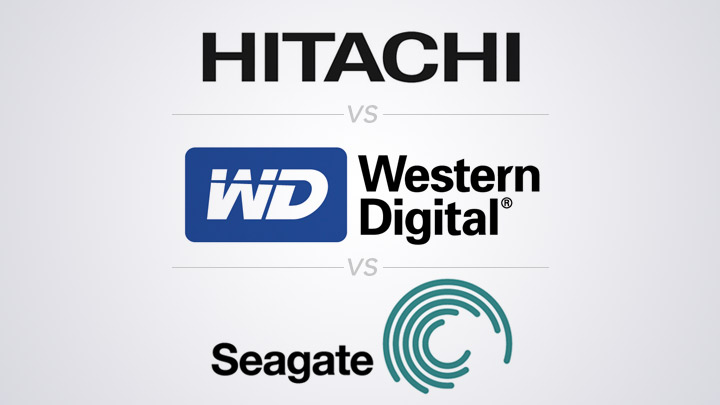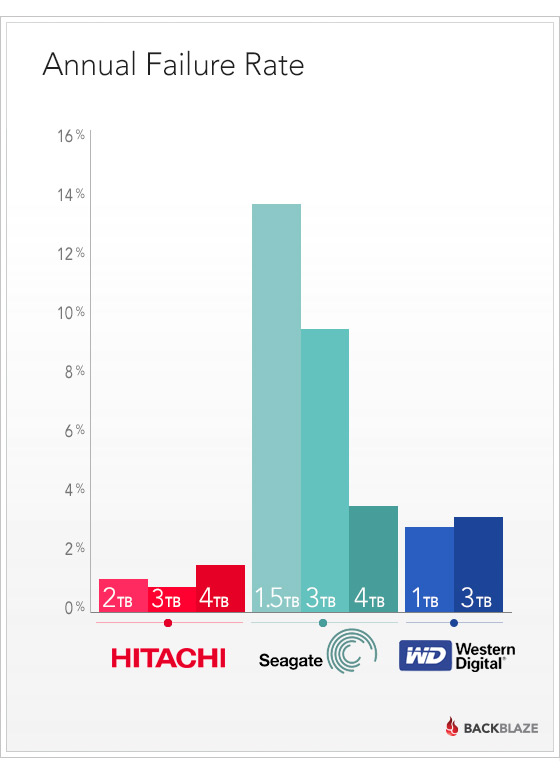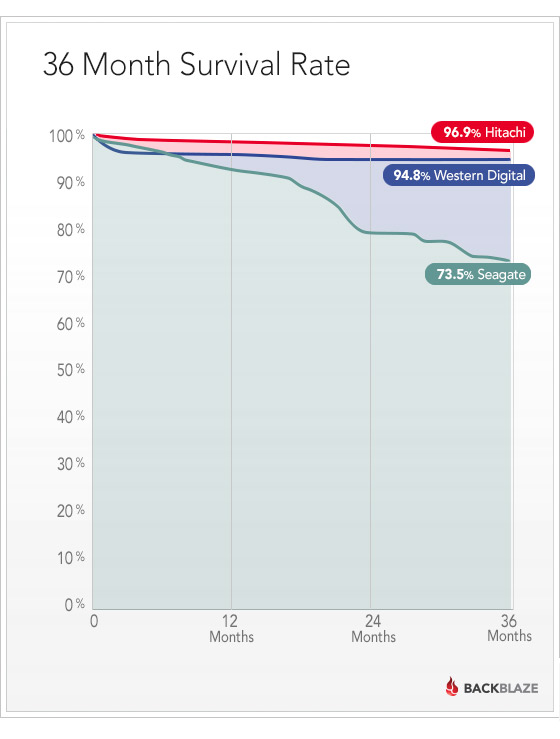My last two blog posts were about expected drive lifetimes and drive reliability. These posts were an outgrowth of the careful work that we’ve done at Backblaze to find the most cost effective disk drives. When we started Backblaze, our goal was to run a truly unlimited online backup service for only $5 per month, meaning our cloud storage needs to be very efficient and we need to quickly figure out which drives work.
Because Backblaze has a history of openness, many readers expected more details in my previous posts. They asked what drive models work best and which last the longest. Given our experience with over 25,000 drives, they asked which ones are good enough that we would buy them again. In this post, I’ll answer those questions.
Drive Population
At the end of 2013, we had 27,134 consumer grade drives spinning in Backblaze Storage Pods. The breakdown by brand looks like this:
| Hard Drives by Manufacturer Used by Backblaze |
|||
| Brand | Number of Drives |
Terabytes | Average Age in Years |
|---|---|---|---|
| Seagate | 12,765 | 39,576 | 1.4 |
| Hitachi | 12,956 | 36,078 | 2.0 |
| Western Digital | 2,838 | 2,581 | 2.5 |
| Toshiba | 58 | 174 | 0.7 |
| Samsung | 18 | 18 | 3.7 |
As you can see, they are mostly Seagate and Hitachi drives, with a good number of Western Digital thrown in. We don’t have enough Toshiba or Samsung drives for good statistical results.
Why do we have the drives we have? Basically, we buy the least expensive drives that will work. When a new drive comes on the market that looks like it would work, and the price is good, we test a Pod full and see how they perform. The new drives go through initial set up tests, a stress test, and then a couple of weeks in production. (A couple of weeks is enough to fill the Pod with data.) If things still look good, that drive goes on the buy list. When the price is right, we buy it.
We are willing to spend a little bit more on drives that are reliable, because it costs money to replace a drive. We are not willing to spend a lot more, though.
Excluded Drives
Some drives just don’t work in the Backblaze environment. We have not included them in this study. It wouldn’t be fair to call a drive “bad” if it’s just not suited for the environment it’s put into.
We have some of these drives running in Storage Pods, but are in the process of replacing them because they aren’t reliable enough. When one drive goes bad, it takes a lot of work to get the RAID back online if the whole RAID is made up of unreliable drives. It’s just not worth the trouble.
The drives that just don’t work in our environment are Western Digital Green 3TB drives and Seagate LP (low power) 2TB drives. Both of these drives start accumulating errors as soon as they are put into production. We think this is related to vibration. The drives do somewhat better in the new low vibration Backblaze Storage Pod, but still not well enough.
These drives are designed to be energy efficient, and spin down aggressively when not in use. In the Backblaze environment, they spin down frequently, and then spin right back up. We think that this causes a lot of wear on the drive.
Failure Rates
We measure drive reliability by looking at the annual failure rate, which is the average number of failures you can expect running one drive for a year. A failure is when we have to replace a drive in a Pod.
This chart has some more details that don’t show up in the pretty chart, including the number of drives of each model that we have, and how old the drives are:
| Number of Hard Drives by Model at Backblaze |
||||
| Model | Size | Number of Drives |
Average Age in Years |
Annual Failure Rate |
|---|---|---|---|---|
| Seagate Desktop HDD.15 (ST4000DM000) |
4.0TB | 5199 | 0.3 | 3.8% |
| Hitachi GST Deskstar 7K2000 (HDS722020ALA330) |
2.0TB | 4716 | 2.9 | 1.1% |
| Hitachi GST Deskstar 5K3000 (HDS5C3030ALA630) |
3.0TB | 4592 | 1.7 | 0.9% |
| Seagate Barracuda (ST3000DM001) |
3.0TB | 4252 | 1.4 | 9.8% |
| Hitachi Deskstar 5K4000 (HDS5C4040ALE630) |
4.0TB | 2587 | 0.8 | 1.5% |
| Seagate Barracuda LP (ST31500541AS) |
1.5TB | 1929 | 3.8 | 9.9% |
| Hitachi Deskstar 7K3000 (HDS723030ALA640) |
3.0TB | 1027 | 2.1 | 0.9% |
| Seagate Barracuda 7200 (ST31500341AS) |
1.5TB | 539 | 3.8 | 25.4% |
| Western Digital Green (WD10EADS) |
1.0TB | 474 | 4.4 | 3.6% |
| Western Digital Red (WD30EFRX) |
3.0TB | 346 | 0.5 | 3.2% |
| Seagate Barracuda XT (ST33000651AS) |
3.0TB | 293 | 2.0 | 7.3% |
| Seagate Barracuda LP (ST32000542AS) |
2.0TB | 288 | 2.0 | 7.2% |
| Seagate Barracuda XT (ST4000DX000) |
4.0TB | 179 | 0.7 | n/a |
| Western Digital Green (WD10EACS) |
1.0TB | 84 | 5.0 | n/a |
| Seagate Barracuda Green (ST1500DL003) |
1.5TB | 51 | 0.8 | 120.0% |
The following sections focus on different aspects of these results.
1.5TB Seagate Drives
The Backblaze team has been happy with Seagate Barracuda LP 1.5TB drives. We’ve been running them for a long time—their average age is pushing four years. Their overall failure rate isn’t great, but it’s not terrible either.
The non-LP 7200 RPM drives have been consistently unreliable. Their failure rate is high, especially as they’re getting older.
| 1.5TB Seagate Drives Used by Backblaze |
||||
| Model | Size | Number of Drives |
Average Age in Years |
Annual Failure Rate |
|---|---|---|---|---|
| Seagate Barracuda LP (ST31500541AS) |
1.5TB | 1929 | 3.8 | 9.9% |
| Seagate Barracuda 7200 (ST31500341AS) |
1.5TB | 539 | 3.8 | 25.4% |
| Seagate Barracuda Green (ST1500DL003) |
1.5TB | 51 | 0.8 | 120.0% |
The Seagate Barracuda Green 1.5TB drive, though, has not been doing well. We got them from Seagate as warranty replacements for the older drives, and these new drives are dropping like flies. Their average age shows 0.8 years, but since these are warranty replacements, we believe that they are refurbished drives that were returned by other customers and erased, so they already had some usage when we got them.
Bigger Seagate Drives
The bigger Seagate drives have continued the tradition of the 1.5TB drives: they’re solid workhorses, but there is a constant attrition as they wear out.
| 2.0 to 4.0TB Seagate Drives Used by Backblaze |
||||
| Model | Size | Number of Drives |
Average Age in Years |
Annual Failure Rate |
|---|---|---|---|---|
| Seagate Desktop HDD.15 (ST4000DM000) |
4.0TB | 5199 | 0.3 | 3.8% |
| Seagate Barracuda (ST3000DM001) |
3.0TB | 4252 | 1.4 | 9.8% |
| Seagate Barracuda XT (ST33000651AS) |
3.0TB | 293 | 2.0 | 7.3% |
| Seagate Barracuda LP (ST32000542AS) |
2.0TB | 288 | 2.0 | 7.2% |
| Seagate Barracuda XT (ST4000DX000) |
4.0TB | 179 | 0.7 | n/a |
The good pricing on Seagate drives along with the consistent, but not great, performance is why we have a lot of them.
Hitachi Drives
If the price were right, we would be buying nothing but Hitachi drives. They have been rock solid, and have had a remarkably low failure rate.
| Hitachi Drives Used by Backblaze |
||||
| Model | Size | Number of Drives |
Average Age in Years |
Annual Failure Rate |
|---|---|---|---|---|
| Hitachi GST Deskstar 7K2000 (HDS722020ALA330) |
2.0TB | 4716 | 2.9 | 1.1% |
| Hitachi GST Deskstar 5K3000 (HDS5C3030ALA630) |
3.0TB | 4592 | 1.7 | 0.9% |
| Hitachi Deskstar 5K4000 (HDS5C4040ALE630) |
4.0TB | 2587 | 0.8 | 1.5% |
| Hitachi Deskstar 7K3000 (HDS723030ALA640) |
3.0TB | 1027 | 2.1 | 0.9% |
Western Digital Drives
Back at the beginning of Backblaze, we bought Western Digital 1.0TB drives, and that was a really good choice. Even after over four years of use, the ones we still have are going strong.
We wish we had more of the Western Digital Red 3TB drives (WD30EFRX). They’ve also been really good, but they came after we already had a bunch of the Seagate 3TB drives, and when they came out their price was higher.
| Western Digital Drives Used by Backblaze |
||||
| Model | Size | Number of Drives |
Average Age in Years |
Annual Failure Rate |
|---|---|---|---|---|
| Western Digital Green (WD10EADS) |
1.0TB | 474 | 4.4 | 3.6% |
| Western Digital Red (WD30EFRX) |
3.0TB | 346 | 0.5 | 3.2% |
| Western Digital Green (WD10EACS) |
1.0TB | 84 | 5.0 | n/a |
What About Drives that Don’t Fail Completely?
Another issue when running a big data center is how much personal attention each drive needs. When a drive has a problem, but doesn’t fail completely, it still creates work. Sometimes automated recovery can fix this, but sometimes a RAID array needs that personal touch to get it running again.
Each Storage Pod runs a number of RAID arrays. Each array stores data reliably by spreading data across many drives. If one drive fails, the data can still be obtained from the others. Sometimes, a drive may “pop out” of a RAID array but still seem good, so after checking that its data is intact and it’s working, it gets put back in the RAID to continue operation. Other times a drive may stop responding completely and look like it’s gone, but it can be reset and continue running.
Measuring the time spent in a “trouble” state like this is a measure of how much work a drive creates. Once again, Hitachi wins. Hitachi drives get “four nines” of untroubled operation time, while the other brands just get “two nines.”
| Untroubled Operation of Drives by Manufacturer Used at Backblaze |
|||
| Brand | Active | Trouble | Number of Drives |
|---|---|---|---|
| Seagate | 99.72 | 0.28% | 12459 |
| Western Digital | 99.83 | 0.17% | 933 |
| Hitachi | 99.99 | 0.01% | 12956 |
Drive Lifetime by Brand
The chart below shows the cumulative survival rate for each brand. Month by month, how many of the drives are still alive?
Hitachi does really well. There is an initial die-off of Western Digital drives, and then they are nice and stable. The Seagate drives start strong, but die off at a consistently higher rate, with a burst of deaths near the 20 month mark.
Having said that, you’ll notice that even after three years, by far most of the drives are still operating.
What Drives Is Backblaze Buying Now?
We are focusing on 4TB drives for new Pods. For these, our current favorite is the Seagate Desktop HDD.15 (ST4000DM000). We’ll have to keep an eye on them, though. Historically, Seagate drives have performed well at first, and then had higher failure rates later.
Our other favorite is the Western Digital 3TB Red (WD30EFRX).
We still have to buy smaller drives as replacements for older Pods where drives fail. The drives we absolutely won’t buy are Western Digital 3TB Green drives and Seagate 2TB LP drives.
A year and a half ago, Western Digital acquired the Hitachi disk drive business. Will Hitachi drives continue their excellent performance? Will Western Digital bring some of the Hitachi reliability into their consumer grade drives?
Correction: Hitachi’s 2.5″ hard drive business went to Western Digital, while the 3.5″ hard drive business went to Toshiba.
At Backblaze, we will continue to monitor and share the performance of a wide variety of disk drive models. What has your experience been?
|





